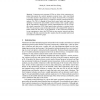Free Online Productivity Tools
i2Speak
i2Symbol
i2OCR
iTex2Img
iWeb2Print
iWeb2Shot
i2Type
iPdf2Split
iPdf2Merge
i2Bopomofo
i2Arabic
i2Style
i2Image
i2PDF
iLatex2Rtf
Sci2ools
RV
2010
Springer
2010
Springer
Interval Analysis for Concurrent Trace Programs Using Transaction Sequence Graphs
Abstract. Concurrent trace programs (CTPs) are slices of the concurrent programs that generate the concrete program execution traces, where inter-thread event order specific to the given traces are relaxed. For such CTPs, we introduce transaction sequence graph (TSG) as a model for efficient concurrent data flow analysis. The TSG is a digraph of thread-local control nodes and edges corresponding to transactions and possible context-switches. Such a graph captures all the representative interleavings of these nodes/transactions. We use a mutually atomic transaction (MAT) based partial order reduction to construct such a TSG. We also present a non-trivial improvement to the original MAT analysis to further reduce the TSG sizes. As an application, we have used interval analysis in our experiments to show that TSG leads to more precise intervals and more time/space efficient concurrent data flow analysis than the standard models such as concurrent control flow graph.
| Added | 30 Jan 2011 |
| Updated | 30 Jan 2011 |
| Type | Journal |
| Year | 2010 |
| Where | RV |
| Authors | Malay K. Ganai, Chao Wang |
Comments (0)

